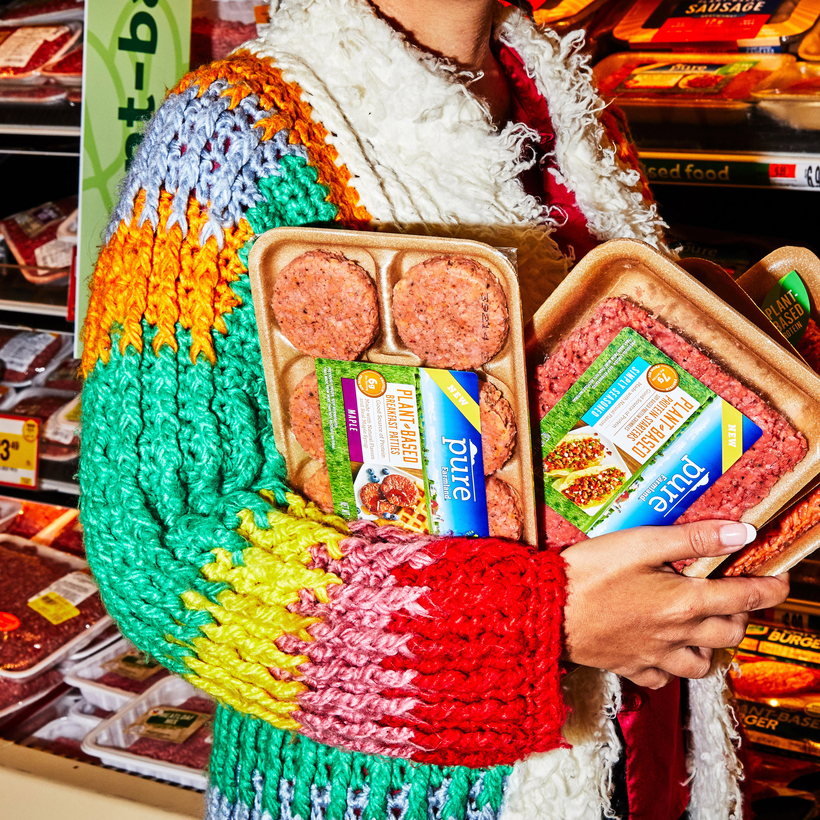This is an opportune time to put out a future-of-food book. In recent weeks, the cooking Web site Epicurious announced that it will no longer publish recipes that call for beef, and the chef Daniel Humm declared that his New York restaurant Eleven Madison Park, considered one of the world’s best, will pivot to entirely meat-free tasting menus. Both Epicurious and Humm specifically cited the ecological cost of raising beef cattle: the resource-depleting farming practices of Big Ag, the climatically dangerous amount of methane produced by gassy bovines.
These bold moves have been partly enabled by the ever increasing availability of meatless options to diners, chefs, and home cooks. In less than five years, Impossible and Beyond Burgers have gone from novelty items to supermarket staples, and they’re only the most recognizable names in the fast-evolving, V.C.-funded industry of “New Food,” to use the journalist Larissa Zimberoff’s term.
Zimberoff was diagnosed with type 1 diabetes as a child. As such, she has spent most of her life investigating the provenance and ingredient lists of everything she considers eating. In Technically Food, she puts this investigative zeal to professional use, visiting Bay Area warehouse labs, convention-center food expos, and a soil-free Newark-based “vertical farm” where edible plants are grown indoors. Her big questions: Are these foods good for you? Do they represent a sustainability upgrade from our current food-production apparatus? Do they taste good? Are these New Food entrepreneurs reliable narrators or hucksters?
Food for Thought
The bulk of Technically Food’s real estate is devoted to plant-based foods, which hold appeal for nutritional and ethical reasons as much as for environmental ones. Zimberoff visits a Boulder, Colorado, company with the acutely startup-ish name Emergy Foods to try a texturally convincing if not wholly toothsome “steak” made from mycelium, an easily cultivated, nutrient-rich fungus. A food-tech bro in a San Francisco café sneaks her a taste of a proprietary algae dust that tastes like cheese but is, disconcertingly, cobalt blue in color. In a Manhattan conference room, she samples a “putty gray” yogurt made from pea protein (which is also used in Beyond Burgers) that, alas, has an “unpleasant, vegetal taste.”

Zimberoff’s interview subjects come off more likably than I expected them to, their motives more noble than their counterparts in, say, the social-media sector. But I can’t help but wonder if New Food is really the solution to what ails us. There’s something so clinical and joyless about the term “plant-based food,” suggestive as it is of slurries and extracts produced by whirling stuff in a centrifuge. Whither the horn-of-plenty imagery of “fruits, vegetables, and grains?”
In a segment devoted to legume-derived products, Zimberoff writes, almost in passing, “Planting a wide variety of crops may be the most important thing we can do to slow climate change. Peas, mung beans, chickpeas, and every other nameless pulse, bean, or legume that we haven’t tested widely yet can help restore our soil and improve our diets. Far from some fancy tech start-up with millions of dollars in funding, this basic farming solution could mean we wouldn’t have to choose between our health and the environment.”
Well, yeah. Isn’t this ultimately the ticket? So much energy, brainpower, and money is going into New Food. But since we’re already talking about re-inventing the wheel and achieving the impossible, why not, once and for all, take on our flawed, industrialized, lobbyist-protected farming systems? Wouldn’t that be a wiser allocation of all this enthusiasm and will?
With New Food, it seems that there’s always another shoe about to drop. Almond milk, far from being eco-sustainable, turns out to require a ton of water to produce. The Beyond Burger, while cruelty-free, is an ultra-processed product that, with all the fixin’s, is nutritionally no better for you than a hamburger. Soylent Green is people.
The most lasting benefits of the experiments Zimberoff chronicles may be the least sexy. She notes that Albert Straus, of Marin County’s locally beloved Straus Family Creamery, is experimenting with feeding his cattle a natural seaweed supplement that makes them significantly less flatulent, therefore bringing him closer to the creamery’s goal of achieving carbon-neutral status by the end of this year.
Technically Food reads agreeably and pluckily, like an extended New Yorker–style dispatch from Silicon Valley. But it’s more a snapshot in time than a cornerstone of your food-lit library; its ventures and products may be busts by this time next year. My hope is that, like such food historians before her as Harvey Levenstein and the Michaels Pollan and Moss, Zimberoff keeps at it, checking back in on her subjects, amassing a trilogy or tetralogy of books that definitively tells the story of “future food” as it evolves over this decade.
David Kamp is a New York–based writer and the author of Sunny Days: The Children’s Television Revolution That Changed America


